Home
A comprehensive resource for safe and responsible laser use
New Zealand: Government report on regulatory effectiveness in controlling laser pointers
A June 2019 report by the New Zealand Ministry of Health takes a look at regulatory controls on laser pointers over 1 milliwatt, during the fifth yearly period (March 2018 - February 2019) since the controls were enacted in March 2014.
The following is from the Conclusions section of the report:
"The Ministry’s implementation of the Health (High-power laser pointer) Regulations 2013 and the associated Customs Import Prohibition Order has continued smoothly. The work has not created a large burden for health officials and others involved.
Advertising of HPLPs on auction websites is increasing slowly. Advertising of HPLPs of a power far greater than that on the label continues to be a problem.
In the coming year, the Ministry will continue its surveillance of Trade Me and other websites, and will conduct further discussions with Trade Me on possible additional controls, especially for overseas sellers.
It is of continuing concern that numbers of laser strikes on aircraft continue to increase. [From 173 reported laser strikes in 2017, to 238 in 2018]
Countries vary in their approaches to managing the risks from HPLPs, from raising public awareness to calling for voluntary improvements in labelling. However, there is consistency in terms of the strong controls countries apply to address aircraft laser strikes, including bans and high penalties.
The Ministry will arrange to meet with other agencies, including the Ministries of Transport and Justice, the Civil Aviation Authority, New Zealand Customs and the New Zealand Police, to discuss potential additional controls in response to the increasing laser strike reports."
Use the "Click to read more…" link below to view selected text and statistics from the report, which is available online in Microsoft Word format and in PDF format. A summary is available from a news article at Stuff.co.nz, "Rising laser pointer sales spied on as health bosses are unhappy at aircraft attacks".
The following is from the Conclusions section of the report:
"The Ministry’s implementation of the Health (High-power laser pointer) Regulations 2013 and the associated Customs Import Prohibition Order has continued smoothly. The work has not created a large burden for health officials and others involved.
Advertising of HPLPs on auction websites is increasing slowly. Advertising of HPLPs of a power far greater than that on the label continues to be a problem.
In the coming year, the Ministry will continue its surveillance of Trade Me and other websites, and will conduct further discussions with Trade Me on possible additional controls, especially for overseas sellers.
It is of continuing concern that numbers of laser strikes on aircraft continue to increase. [From 173 reported laser strikes in 2017, to 238 in 2018]
Countries vary in their approaches to managing the risks from HPLPs, from raising public awareness to calling for voluntary improvements in labelling. However, there is consistency in terms of the strong controls countries apply to address aircraft laser strikes, including bans and high penalties.
The Ministry will arrange to meet with other agencies, including the Ministries of Transport and Justice, the Civil Aviation Authority, New Zealand Customs and the New Zealand Police, to discuss potential additional controls in response to the increasing laser strike reports."
Use the "Click to read more…" link below to view selected text and statistics from the report, which is available online in Microsoft Word format and in PDF format. A summary is available from a news article at Stuff.co.nz, "Rising laser pointer sales spied on as health bosses are unhappy at aircraft attacks".
Implementation of New Regulatory Controls on High-power Laser Pointers: Year 5
1 March 2018 - 28 February 2019Published in June 2019 by the Ministry of Health PO Box 5013, Wellington 6140, New Zealand
Background to the controls (Appendix)
In December 2013, the Government introduced new regulations to manage the health and safety risks from High-power Laser Pointers (HPLPs). These came into force on 1 March 2014.
- The Customs Import Prohibition (High-power Laser Pointers) Order 2017 (CIPO) restricts the importation of HPLPs to people authorised to import them by the Director-General of Health. The CIPO is made under the Customs and Excise Act 1996 and administered by the New Zealand Customs Service.
- The Health (High-power Laser Pointers) Regulations 2013 restrict the sale/supply of HPLPs to authorised suppliers, and also restrict their acquisition to authorised recipients. They are made under the Health Act 1956 and administered by the Ministry of Health.
The regulatory controls do not ban laser pointers outright. They impose controls on the supply chain, and require people to justify why they need a higher-power device (as opposed to a lower-power one).
The controls only apply to laser pointers with an output power of greater than 1 milliwatt (mW), and devices which, in the Director-General’s opinion, are commonly known as laser pointers. Using this discretion, the Director-General has determined that some types of device (for example, those used in surveying, or those sold with fixtures for mounting on a firearm as a sighting aid) do not come within the scope of the Regulations.
In addition, the Regulations automatically authorise classes of people who use laser pointers for certain purposes, such as members of astronomical societies and people who use laser pointers for industrial and research purposes. However, these people must still be able to provide proof that they belong to the exempt class if required; for example, when they are acquiring an HPLP. People in exempt classes must still obtain authorisation if they wish to import an HPLP.
In July 2014, the Government amended the Summary Offences Act 1981 to make it an offence to be in possession of an HPLP in a public place without a reasonable excuse. This legislation is administered by the Ministry of Justice and enforced by the Police.
Introduction to the report
This report discusses the Ministry of Health’s implementation of regulatory controls on high-power laser pointers (HPLPs) over the fifth year since those controls came into force on 1 March 2014. The Government introduced these controls to manage the risks arising from the ready availability, at low cost, of powerful hand-held, battery-operated laser pointers, by limiting the supply.
Immediately after the controls were introduced, the availability of these devices on New Zealand-based auction websites and in shops dropped significantly, but advertising on auction sites has slowly increased since that time. Reported incidents of HPLPs being shone at aircraft initially showed a small decrease, and then a gradual increase.
Implementation of the controls has not created a large burden for officials. In the past year, the number of applications for authorisations under the controls decreased to 24, of which 19 were granted. The Ministry updates information about the regulations on its website when necessary, to provide further clarity on frequently asked questions.
Surveillance work planned for the coming year will again focus on online sales, alongside limited retailer visits.
While the increase in reported laser strikes on aircraft is disappointing, it is not inconsistent with some trends overseas. The High-Power Laser Pointer Offences and Penalties Bill proposes amendments to existing offence provisions in various Acts, and an increase in penalties for the use and possession of HPLPs. The increase in available penalties is consistent with regulatory controls in some other countries. The Ministry will meet with other agencies to consider these proposed amendments and what additional actions, if any, might be taken in response to the increase in reported laser strikes.
This document reports on the Ministry of Health’s activity in terms of regulation of HPLPs in the most recent implementation year. It looks at numbers of authorisations and the extent of public interest in the regulations for this period, then goes on to report on surveillance and compliance activity, on the part of the Ministry itself and then on the part of the New Zealand Customs Service and the New Zealand Police respectively. It discusses the High-Power Laser Pointer Offences and Penalties Bill, and then looks at recent overseas activity in the area of regulation of HPLPs. The Appendix to this report provides a full description of the legislative background.
2. Authorisations
2.1 Applications
Figure 1 below summarises the outcomes of all applications for authorisation to import, supply or acquire HPLPs (or any combination of those activities) since the regulations came into force.
Most applications in 2018/19 were for importing, by users who already belonged to a pre-approved class of applicant. The main reason for declining applications was insufficient information on the proposed use.
In general, the Ministry continues to encounter few problems in its processing of applications. It requests external technical advice if there is doubt over the use proposed for the HPLP, or a particular device’s output power. Where the Ministry has imposed conditions on an authorisation, these have generally been for the purpose of limiting the import/supply/acquisition to the types and quantities of HPLPs described in the application, and for the uses described. The Ministry’s authorisation letters highlight the importance of safe storage of HPLPs, and the obligations specified within the Health and Safety at Work Act 2015.
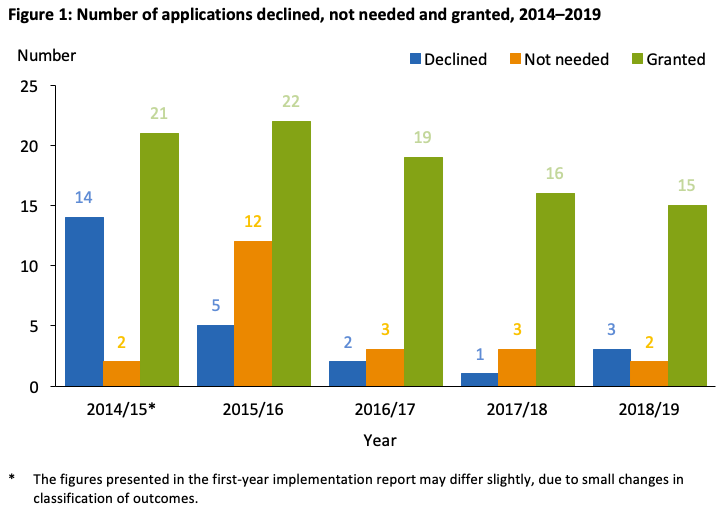
2.2 Public information
Since the regulations came into force, the Ministry has maintained a webpage providing an overview of the regulations, and a ‘Questions and Answers’ section. Figure 2 presents numbers of page views on those two pages, not counting repeat visits by the same user.
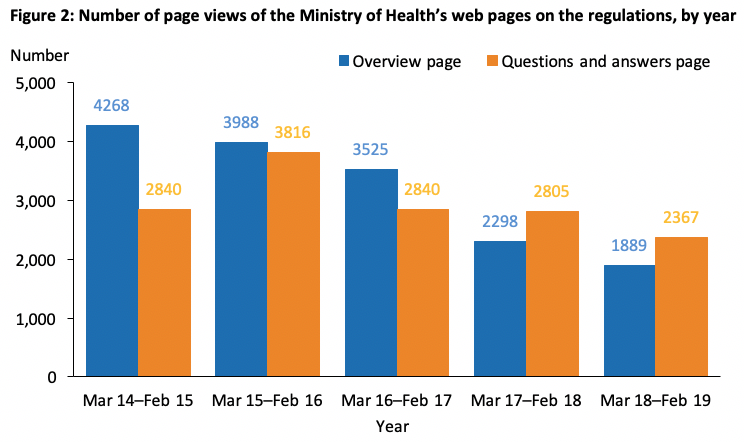
Table 1 summarises queries about the regulations the Ministry has received by phone or email since the regulations were introduced.

3. Surveillance and compliance
During this annual implementation period, the Ministry’s surveillance and compliance activities have concentrated on online sales, rather than shop visits.
3.1 Retailer visits
The Ministry made no formal retailer visits during this implementation period. One informal visit to some shops by a Ministry enforcement officer resulted in warnings to the retailers.
3.2 Distributor visits
The Ministry did not undertake any distributor visits during this implementation period.
3.3 Online surveillance
3.3.1 Trade Me surveillanceBefore the introduction of the regulations, HPLPs were readily available at low prices through online auction sites, including Trade Me. When the regulations came into force, Trade Me placed HPLPs on their ‘Banned and Restricted’ list. Initially, Trade Me did not permit international sellers to list HPLPs on Trade Me, but this restriction appears to have since been relaxed.
Figure 3 shows the numbers of individual listings for HPLPs considered to fall within the scope of the regulations, obtained through weekly surveillance of Trade Me.
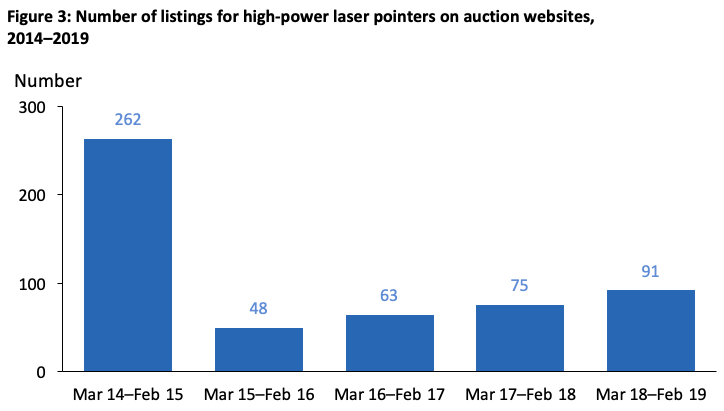
This figure shows that, after the initial decrease, the number of listings has been rising slowly. This indicates that the Ministry’s surveillance should continue. Many of the HPLPs listed on Trade Me during this implementation period have been well over 1 milliwatt (mW) (see Appendix for information on the output power of HPLPs). As in previous years, the Ministry has found that a few sellers gave false descriptions, claiming untruthfully that their pointers had an output power of less than 1 mW. In addition, an increasing number of pointers have been advertised by overseas sellers.
The Ministry notes that Trade Me is quick to remove listings when it has reason to believe that a pointer falls within the scope of the regulations. During this implementation period, the Ministry continued to use its Compliance Account to bring sellers’ attention to the regulations, and to ask questions about devices where the output power was less evident. The Ministry occasionally purchases pointers for testing.
The Ministry would like to acknowledge the assistance it has received from Trade Me. It will conduct further discussions with Trade Me on potential additional controls, especially for overseas sellers.
3.3.2 Other online sales
The Ministry did not undertake surveillance of other New Zealand-based online sales outlets during this implementation period. The Ministry has no control over online sales in other countries.
4 New Zealand Customs Seizures
The Customs Import Prohibition (High-power Laser Pointers) Order 2017 (CIPO) prohibits importation of HPLPs until 28 February 2020.
Table 2 summarises HPLPs seized by New Zealand Customs since 2014. (The comments in this table make mention of certain Asian countries; the Ministry notes that HPLPs are unregulated, and widely available, in Southeast Asia.)
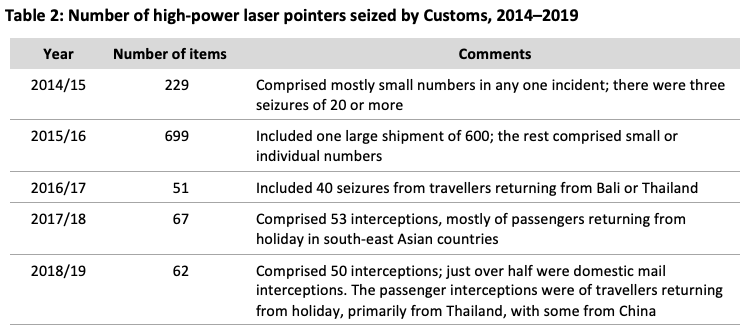
While Customs does not specifically target HPLPs, it does look for them in the mail stream, and ask passengers about them at the border. There are no customs codes that allow HPLPs to be readily identified from import paperwork. The Ministry notifies Customs of all authorisations to import HPLPs; it also notifies Customs of potential non-authorised importers.
5 Other agencies
5.1 New Zealand Police
Figure 4 records the New Zealand Police’s data on proceedings against offenders for breaches of the Summary Offences Act 1981 through being in possession of a HPLP in a public place without a reasonable excuse (see Appendix).
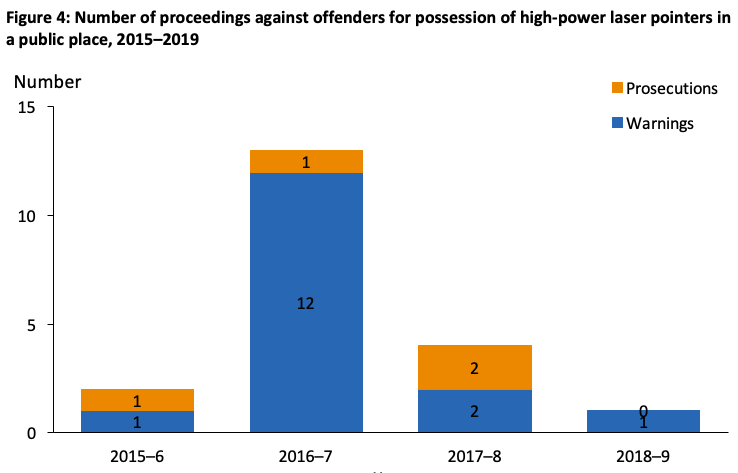
Academic staff at the University of Auckland test laser pointers at an evidential standard where required for a prosecution. On one occasion during the implementation period, they assisted police by testing a laser that had been shone at officers investigating other offences. This resulted in a successful prosecution for criminal nuisance.
5.2 Civil Aviation Authority
The Civil Aviation Authority reports the following data on laser strikes on aircraft in New Zealand since 2008.
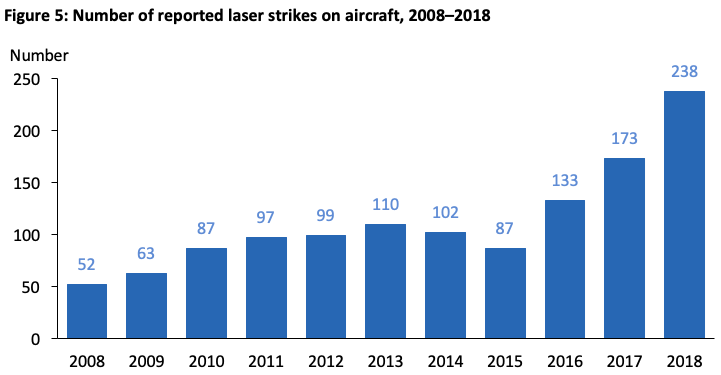
As this figure shows, these incidents continue to increase.
6 The High-Power Laser Pointer Offences and Penalties Bill
The High-Power Laser Pointer Offences and Penalties Bill (the Bill) has been drawn from the ballot as a private member’s bill, in the name of Hamish Walker (National), and is currently awaiting its first reading. The Bill would amend existing offence provisions within the Crimes Act 1961 and Summary Offences Act 1981. It would also insert a new section (136A) into the Health Act 1956 to provide higher penalties for a breach of regulations under the Health (High-power Laser Pointers) Regulations 2013, increasing the $500 fine to a prison term not exceeding six months or a fine not exceeding $4,000.
7 Overseas developments
[This section looks at recent laser pointer issues and regulations in the U.K., Switzerland, Canada, the U.S., and Australia. We are not reprinting this section; it is available as pages 10-12 in the in Microsoft Word format and in PDF format online versions.]
8 Conclusions
The Ministry’s implementation of the Health (High-power laser pointer) Regulations 2013 and the associated Customs Import Prohibition Order has continued smoothly. The work has not created a large burden for health officials and others involved.
Advertising of HPLPs on auction websites is increasing slowly. Advertising of HPLPs of a power far greater than that on the label continues to be a problem.
In the coming year, the Ministry will continue its surveillance of Trade Me and other websites, and will conduct further discussions with Trade Me on possible additional controls, especially for overseas sellers.
It is of continuing concern that numbers of laser strikes on aircraft continue to increase.
Countries vary in their approaches to managing the risks from HPLPs, from raising public awareness to calling for voluntary improvements in labelling. However, there is consistency in terms of the strong controls countries apply to address aircraft laser strikes, including bans and high penalties.
The Ministry will arrange to meet with other agencies, including the Ministries of Transport and Justice, the Civil Aviation Authority, New Zealand Customs and the New Zealand Police, to discuss potential additional controls in response to the increasing laser strike reports.